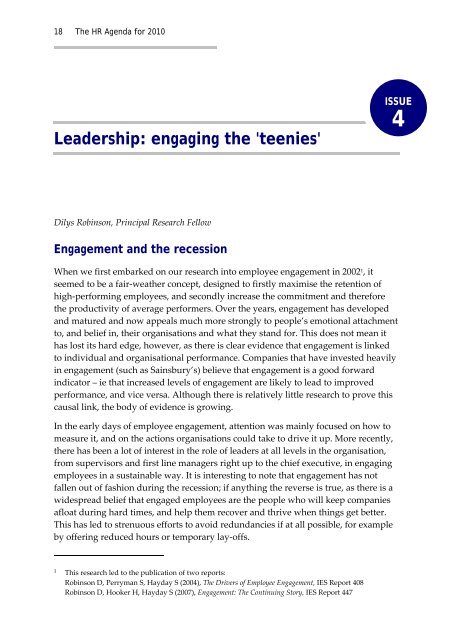PDF of this item - The Institute for Employment Studies
PDF of this item - The Institute for Employment Studies
PDF of this item - The Institute for Employment Studies
- No tags were found...
You also want an ePaper? Increase the reach of your titles
YUMPU automatically turns print PDFs into web optimized ePapers that Google loves.
18 <strong>The</strong> HR Agenda <strong>for</strong> 2010Leadership: engaging the 'teenies'ISSUE4Dilys Robinson, Principal Research FellowEngagement and the recessionWhen we first embarked on our research into employee engagement in 2002 1 , itseemed to be a fair‐weather concept, designed to firstly maximise the retention <strong>of</strong>high‐per<strong>for</strong>ming employees, and secondly increase the commitment and there<strong>for</strong>ethe productivity <strong>of</strong> average per<strong>for</strong>mers. Over the years, engagement has developedand matured and now appeals much more strongly to people’s emotional attachmentto, and belief in, their organisations and what they stand <strong>for</strong>. This does not mean ithas lost its hard edge, however, as there is clear evidence that engagement is linkedto individual and organisational per<strong>for</strong>mance. Companies that have invested heavilyin engagement (such as Sainsbury’s) believe that engagement is a good <strong>for</strong>wardindicator – ie that increased levels <strong>of</strong> engagement are likely to lead to improvedper<strong>for</strong>mance, and vice versa. Although there is relatively little research to prove <strong>this</strong>causal link, the body <strong>of</strong> evidence is growing.In the early days <strong>of</strong> employee engagement, attention was mainly focused on how tomeasure it, and on the actions organisations could take to drive it up. More recently,there has been a lot <strong>of</strong> interest in the role <strong>of</strong> leaders at all levels in the organisation,from supervisors and first line managers right up to the chief executive, in engagingemployees in a sustainable way. It is interesting to note that engagement has notfallen out <strong>of</strong> fashion during the recession; if anything the reverse is true, as there is awidespread belief that engaged employees are the people who will keep companiesafloat during hard times, and help them recover and thrive when things get better.This has led to strenuous ef<strong>for</strong>ts to avoid redundancies if at all possible, <strong>for</strong> exampleby <strong>of</strong>fering reduced hours or temporary lay‐<strong>of</strong>fs.1This research led to the publication <strong>of</strong> two reports:Robinson D, Perryman S, Hayday S (2004), <strong>The</strong> Drivers <strong>of</strong> Employee Engagement, IES Report 408Robinson D, Hooker H, Hayday S (2007), Engagement: <strong>The</strong> Continuing Story, IES Report 447
















